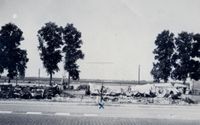Willemsdorp - May 1940.
On this page, you will find original photo material of the small village of Willemsdorp between Dordrecht and the Moerdijk bridges in May 1940. Many Dutch soldiers were stationed in Willemsdorp during the mobilization, which resulted in direct confrontations between them and the German paratroopers who landed in the meadows there.
The first photo shows the residential house near the car dismantling yard in Willemsdorp, close to the police troop barracks. A German aircraft bomb hit the car dismantling yard. Among the Dutch troops, there was a belief that German forces had a gathering point for vehicles there. Apparently, they overlooked the fact that the large number of vehicles may have been due to the presence of the car dismantling yard. Dutch artillery then heavily targeted the car dismantling yard, completely leveling what remained of it. As far as is known, no German vehicles were hit. *1
The second photo is a very rare and unique image taken during the fighting in May 1940. Fallschirmjägers are positioned with their heavy machine gun near Willemsdorp. These are probably units from the 12./FJR 1, which was the heavy machine gun company of the 3rd battalion. In the background to the left (just above the machine gun), there appear to be two vehicles that were requisitioned by the Germans. Slightly more to the right in the center, there is a Dutch 7-field gun. Several of these artillery pieces had been captured by German paratroopers from the 17th Artillery Regiment and were set up to defend the Moerdijk bridgehead. In the background lies the police troops barracks (now Hotel Willemsdorp). The smoke clouds were caused by Dutch artillery fire. The photo was probably taken between May 11 and May 14, 1940. Nowadays, the spot where the German paratroopers were positioned is a truck parking lot just past the gas station. *2
Another image follows of the car scrapyard in Willemsdorp, taken from a slightly different angle. At the marked cross, there is the grave of a German paratrooper. He was presumably killed on May 10, shortly after landing during the assault on the Dutch positions in Willemsdorp. The back of the photo is inscribed:
"So haben Fallschirmjäger Holl. Angriffe an der Rhein-Brücke vor Rotterdam abgewiesen. (X Grab eines dtsch. Fallschirm-Jäger)."
Here, they refer to the "Rhein-Brücke," but this must actually be the bridge over the Hollandsch Diep, namely the Moerdijk bridge.
The following photos show the battles near Willemsdorp. The first photo depicts two farm barns on fire. The photo was probably taken near Willemsdorp (it belongs to the series of Willemsdorp photos that follow).
The back of the photo is inscribed: Holland, fire caused by hand grenades, May 1940.
The next photo appears to be of one of the two artillery pieces from the Fallschirmjäger Artillery Battalion 7 (Zirkus Schramm), the same unit commanded by Oberleutnant Schramm. The crew is firing, likely at Dutch troops on the other side of the Dordtse Kil. The stance of the German gun crew suggests that Dutch fire is also being directed at their own positions.
Fallschirmjäger Artillery Battalion 7 had four Skoda mountain guns (Gebirgskanone 15L/13). Two of them were sent to Willemsdorp and two to the Zwijndrecht bridges. The artillery pieces and their crews were flown in via Waalhaven airfield, which explains why the gun crew is not wearing paratrooper gear but rather the helmet and equipment of the regular German army.
It is an intriguing photograph. *3
Below are photos that clearly depict the damage in Willemsdorp as a result of the fighting in May 1940. Among other things, we see the Willemsdorp scrapyard and the police troops barracks. The Willemsdorp barracks camp has been completely leveled in these photos due to Dutch artillery fire. Unfortunately, several Dutch soldiers lost their lives due to this artillery fire, as they were being held captive there by German paratroopers. Additionally, the police troops barracks were used as a medical post until artillery fire made this impossible. In the second-to-last photo, we see Dutch emergency shelters for Dutch prisoners of war, hastily dug to provide some protection against the violence of war. They are well camouflaged. Photo 12 clearly illustrates the extent of the damage caused in May 1940. *4
The first photo below shows another destroyed building as a result of the May days in Willemsdorp. A German vehicle is still standing in front of it. In the photo below, German paratroopers can be seen with a captured piece of I-17 R.A. The guns were positioned in the fields along Vlaakweg and were captured by paratroopers from Fallschirmjäger Regiment 1 in the early morning of May 10, 1940. The Germans themselves used these guns during May 1940. These are most likely paratroopers from the II Battalion.
©2017-2025 :Https://www.Dordrechtindeoorlog.nl: (There is a copyright on the content of this website. This content is not to be shared, duplicated or published withouth the explicit permission of the author of this website. If you have any requests you can email to: Info@Dordrechtindeoorlog.nl or look on : www.dordrechtindeoorlog.nl/termsofuseforthecontentonthiswebsite.
*1 Source: beeldbank Dordt Open stad.
*2 Source: This information was made available to us by Mr. A Goossens.
*3 Source: Zuidfront-Holland1940- 11 mei de status quo rond 04:00 uur.
*4 Source: Zuidfront-Holland1940 - effecten van het artillerievuur.












